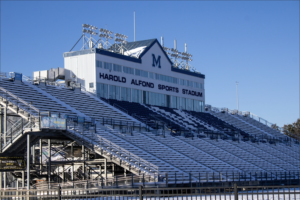With the end of the school year, we can expect to see scores of celebrating college students nationwide. At the University of Maine, we usually see heavy drinking around Maine Day and graduation. Although remote learning may be a party pooper, drinking at UMaine is a serious problem with real consequences.
For university students, alcohol is seen as a rite of passage, a means of socializing, and a key part of partying. This is especially true in Maine, where craft breweries have grown faster than the national average. Maine’s flagship campus has been regularly voted as one of the nation’s top party schools. UMaine students are engrossed in drinking culture. However, UMaine should not encourage students to engage in these potentially catastrophic behaviors.
Despite official UMaine policies, drinking is at best permitted, and at worst encouraged. Officially, UMaine describes how it complies with state laws, meaning that alcohol can only be consumed by individuals over the age of 21 and alcohol must be consumed in individuals’ rooms or “appropriately licensed … campus facilities.” Considering how most students who enroll in college do so immediately following highschool and UMaine’s “Think 30” campaign heavily promotes graduating within four years, then presumably around 75% of our undergraduate population could be estimated to be under Maine’s drinking age. Over 61% of UMaine’s undergraduates are between 18 and 21. This means that very few of UMaine’s undergraduates are legally allowed to drink.
Although most UMaine undergraduates are younger than 21 and UMaine does not officially promote drinking, the unwritten expectation on campus vastly differs. Throughout my college experience, I have personally heard numerous professors and faculty joke about drinking. Faculty have talked about their own drinking, and have even talked about students’ drinking. This is hardly a suitable discussion for professionals dealing with young, impressionable minds.
UMaine’s “Stein Song” is filled with obvious alcoholic references, such as “Stand and drink the toast once again,” and “Drink to all the happy hours.” The UMaine Bookstore sells shot-glasses and flasks. Some of the most celebrated local businesses include the Orono Brewing Company, Margarita’s and Thriftway, all establishments that sell alcohol.
UMaine and Orono police regularly send drunk drivers or underage drinkers to counseling or to court to receive light sentences instead of fines or jail time issued to most convicted legal adults. UMaine’s admissions FAQ page states that UMaine has among the highest Greek life in New England. Pertaining to the party scene, UMaine states: “We’re not going to touch this one.”
Since most undergraduates are younger than 21 and UMaine officially does not condone drinking, it is reprehensible how the university and surrounding community promotes drinking through jocular faculty, a strong drinking culture, alcohol and paraphernalia sales, lax punishments for students who break the law, and the influx of “watering holes” so close to campus.
Alcoholism is not a lighthearted, fun activity for youth. The Diagnostic Statistical Manual 5 (DSM-5) classifies individuals who exhibit two or more of certain symptoms to have alcohol use disorder (AUD). Some of the symptoms include drinking more than intended, spending much time drinking, or getting into situations where drinking increases chances of injury. The DSM-5 classifies five or more drinks in one session as an instance of binge drinking. I have personally heard numerous college students discuss symptoms that would likely classify them as having AUD, and an incredible 23% of all Americans age 11 or older binge monthly. According to The Washington Post, over 80% of college students drink alcohol, at least 19% of college students are dependent on alcohol and half of college students report binge drinking in the past two weeks. Alcoholism is very prevalent on college campuses, and many college students could even be diagnosed with AUD or binge drinking.
Despite its popularity with collegiate youth and the heavy drinking culture at UMaine, alcohol consumption poses many risks. The National Institute of Health labels college drinking as a “significant public health problem.” Each year in the US, over 1,800 college students die from alcohol poisoning, 3.4 million college students drive while intoxicated, there are 696,000 assaults resulting from alcoholism on campuses and there are 97,000 sexual assaults on college campuses in which alcohol is a factor. While alcohol is the most legal and accepted drug, more people die from alcohol than all other drugs combined.
Alcohol consumption has also been tied to poor academic performance, depression, and other mental health struggles. Brain development continues beyond adolescence, and young drinking can permanently impact frontal lobe growth, leading to permanent impacts on judgment. Since drinking is tied to thousands of failing grades, cases of depression, cases of stunted brain development, assaults, both physical and sexual and deaths on college campuses, it is unacceptable how much of the culture at UMaine encourages excessive drinking.
Drinking is very prevalent on college campuses. Although most undergraduates are below the legal drinking age, UMaine fails to adequately prohibit drinking. Most college students drink, and many are dependent on it or binge drink. However, the thousands of date rapes, mental health crises, assaults, and deaths on college campuses resulting from drinking attest that alcoholism is no light matter. Universities, including UMaine, need to treat alcoholism as a serious condition with punishments, instead of as a lighthearted hobby.



